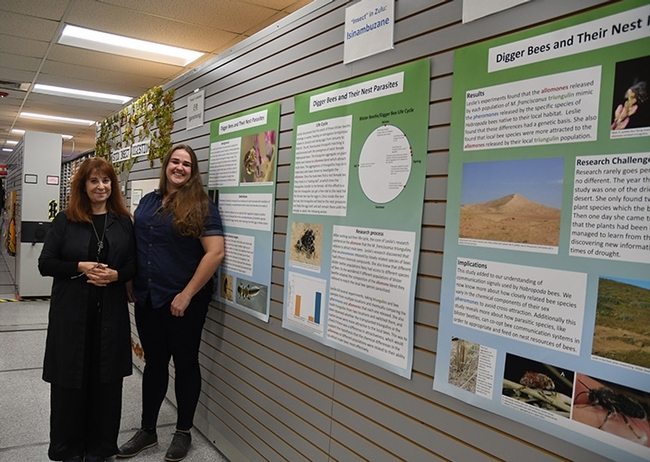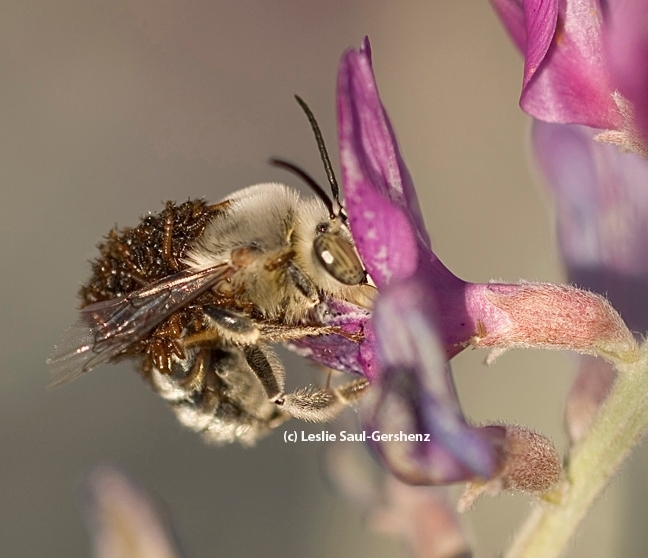
Saul-Gershenz studies how blister beetle nest parasites mimic the sex pheromone of digger bees.
Bohart associate Emma Cluff curated the wall display, “Digger Bees and Their Nest Parasites,” which examines the life cycle, research process, results, research challenges and implications.
Saul-Gershenz, associate director of research, Wild Energy Initiative, at the John Muir Institute of the Environment, UC Davis, researches the chemical ecology and parasite-host interactions of these solitary native bees and their nest parasites across the western U. S., including the coastal sand dunes of Oregon and the Mojave Desert in south-central California.
Leslie did much of her work at the Mojave National Preserve, where she tracked the solitary bee Habropoda pallida and its nest parasite, a blister beetle, Meloe franciscanus.
The larvae of the parasitic blister beetle produce a chemical signal or allomone, similar to that of a female bee's pheromone, to lure males to the larval aggregation. The larvae attach to the male bee on contact and then transfer to the female during mating. The end result: the larvae wind up in the nest of a female bee, where they eat the nest provisions and likely the host egg.
Leslie's experiments found the allomones “released by each population of M. franciscanus triungulin (larvae) mimic the pheromones released by a specific species of Habropoda bees native to their local habitat,” Cluff wrote in the display. “Leslie found that these differences had a genetic basis. She also found that local bee species were more attracted to the allomones released by their local triungulin population.”
The M. franciscanus triungulin hatching is synchronized with the emergence of adult female Habropoda bees,” the display reads. “The triungulins aggregate on plant stems and release an allomone blend which attracts male bees. The aggregation of triungulins hop on to male bees who have chosen to investigate the allomone. Once the male bees find a real female bee, they mate in a ‘mating ball' at which time the triungulins transfer to the female. All this effort is so that the triungulins can get a free ride to the nest that the female bee lays her eggs in. Once inside the nest burrow, the triungulins will feed on the net provisions and likely the egg itself and will remain there until they emerge as adults the following winter.”
Results? “Leslie's experiments found that the allomones released by each population of M. franciscanus triungulin mimic the pheromones released by a the specific species of Habropoda” Cluff wrote. “Leslie found that these differences had a genetic basis. She also found that local bee species were more attracted to the allomones released by their local triungulin population.” The research contributes to the understanding of the communication signals of bees in the genus Habropoda.
Leslie, who holds a doctorate in entomology from UC Davis, is currently finishing two research papers: the basic biology of digger bee Habropoda pallida, and the biology of the silver digger bee Habropoda miserabilis.
She and her husband, Norman, are the co-founders of the Bay Area-based SaveNature.Org. The international conservation consortium works with partners to protect ecosystems around the world.
The Bohart Museum of Entomology, directed by Lynn Kimsey, professor of entomology at UC Davis, houses a global collection of nearly eight million insect specimens. It also includes a gift shop and a live "petting zoo," which includes Madagascar hissing cockroaches, walking sticks, and tarantulas. The museum is open to the public Monday through Thursday from 9 a.m. to noon and from 1 to 5 p.m., except during the holiday schedule. (See website)
The next open house, free and family friendly, will take place from 1 to 4 p.m., Saturday, Jan. 18. It will showcase "the amazing insect work that graduate students are doing," said Tabatha Yang, education and outreach coordinator. The theme is "Time Flies When You Are Studying Insects: Cutting Edge Student Research."
Attached Images:

